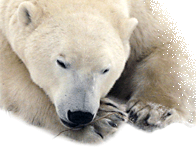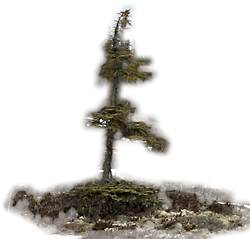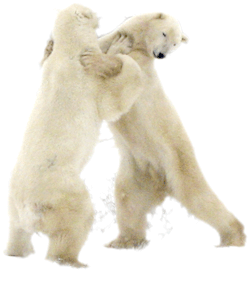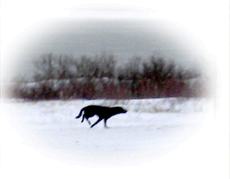
Travels northwest 2006
The Port of Churchill, 58.5 degrees North and 94 degrees West on the coast of Hudson Bay in Northern Manitoba, is already slick with ice in the first days of November. It is studded with military installations, artefacts left by the Canadian Navy and the Strategic Air Command. The roads east of town, in fact, were built for Canadian Forces war games and to retrieve rockets launched to study the Aurora Borealis. Nowadays, in "bear season," the roads serve a new army come to study the Ursus Maritimus. Buggy loads of eager tourists jolt along the roads, going to see the polar bears. The bears are congregating at Cape Polar Bear, waiting for the Bay to freeze.
But we’re headed 25 km west of the port, or a 10 minute flight over the Churchill River and up the Bay. Just off the coast on the shore of Lake Dymond is Churchill Wild's Dymond Lake Lodge. Here, the guests do not go out to the bears, the bears come all around us. Well, one bear does, and he is scary enough. "Arnie" has found the compost pile, and late fall offers slim pickings, so this 400 hundred pound young male keeps coming back, despite volleys of cracker shells and being set upon by the fearless bear dog, a black labrador named Dakota. "We thought he had her," our guide Dennis Fast says, telling us about the fight with Arnie the day before," but she’s just a little sore."
But Arnie has learned to not come too close, so our sightings of him are from a safe distance. Later, when I leave the lodge and take that tundra-buggy ride to study bears up close at Cape Polar Bear, I watch a big male loll about. The smaller bears scoot respectfully out of his way. His head is enormous, his glance stony, his nose might just be spanned by my spread out hand, his paws and claws are huge. I wonder at the dog’s survival; as much as I shudder to imagine risking the life of a beloved pet to battle with such a beast.

But she’s the camp bear dog. She’s adapted to her job and no choice but to do it. And the North, it seems, is all about adaptation. Here, where the permafrost below is impenetrable and the wind reigns above, the trees still grow, but with few branches on the side facing the wind, barely to 5 feet tall and after over two hundred years their trunks are still less than a hand width wide. You can tell how deep the snow gets here, by the mat of branches growing low, where in winter they are safe from the wind. North of here, even these spindly stalwarts disappear.
To survive here, the white bears learned to hunt in winter, when other bears hibernate. They go months without food, and can swim in the arctic chill sea, it is said, over 200 kilometres. The bears mate in April, but not until September and then only if a female has filled up on seal will the fertilized egg implant. She goes inland to dig her den and birth her cubs. The eggs do not implant if the winter hunt was poor and she has not gained enough weight to maintain the pregnancy and nurse her cubs for months before she hunts again. "How does the egg survive so long without implantation?" marvels Alice, from Alabama. A Mystery!
I like to get close to nature. But just shy of the Artic Circle? In November? Time to do a little adapting of our own. With Arnie in the willows, we crouch at the coast in the wind, playing spot-the-bear. We are not actually at the shore itself, a mile wide rock strewn mud flat lies between us and the sea. My city-bred eyes cannot detect the distant motion, or a speck of yellow that is a bear, not rock or snow. We wait, and listen to silence. We are new to this world in every way: 4 guests are from large metropolitain areas in Canada, 2 from Manchester, England, and 6 from the US, most of those from the American South. Around us is arid tundra, rocks, ice and water, and nothing but horizon. The highest object and the only human presence in miles is our lodge back at the lake. We cannot step out of that lodge without armed escort. "Not the teeming life of the Galapagos, is it?" remarks Norman, who with Julie his wife must feel he has changed planets, not just planes, in travelling from Florida.
Yet even here, the world we left is with us, connected -- at least while the generator is on -- with wireless, laptop, Bluetooth and Vonage. At one point, Dennis sends an email from the guest lodge, via satellite, to Mike in the main lodge. "You could have just shouted," says an exasperated Mike. Nine people, plus more in town, labour to keep 12 guests in safety, luxury and feasts. We eat snow goose, venison, caribou lasagne, wild rice and mushroom casserole, maple marinated pickerel, and -- my new old favourite -- Red River Cereal. The game and fish was probably shot or caught by Mike, skinned/dressed and packed up where it fell, and frozen after the trek home.
Mike Reimer is part of the Webber clan who runs "Churchill Wild", the outfit behind this "Great Ice Bear" tour we are on. He is partner to Jeanne the chef, the daughter of Doug and Helen Webber. They built the Dymond Lake Lodge in 1969, and now with their extended family and friends they run 2 other lodges as well. Down in the boreal forest is their fishing lodge at North Knife Lake, and further up the coast near Seal River is a lodge where one can experience the Arctic in summer. Jeanne and Mike built that one by themselves. When we later meet Helen, back in Churchill for our farewell feast at her home, she explains it was her mother’s fault. "She never taught me there was anything I couldn't do." Her mother was trekking upwards of two weeks by sled dogs with infants to and from their trading post 240 miles north of Churchill, in the 1940s.
Our small task is to hike 'there and back'. To the coast, and home for lunch. To the coast and home for cocktails, hors d'oeuvres, followed by slideshows by Dennis Fast, who is a professional photographer as well as raconteur, teacher and our guide. After supper at our lakeshore lodge, Alice reads aloud from his book Wapusk. On our third day, we hike an hour or two over the spongy tundra -- the sage green caribou moss set off by the purple saxifrage -- to the "ridge", it must be. . . oh.. I’d say ... all of 4 feet higher. George, our silent Cree guardian, packs in the food for us all, and builds the fire for our picnic. The picnic involves sandwiches, baking bannock on a stick and sipping a "tundraccino" (add a spoonful of cocoa to your coffee). Norman has become quite the quiet enabler of our group and asks George to take a commemorative group photo. This once, and once only, George speaks: "Say Bannock!" as he clicks the shutter.

On the fifth day, when we take that Tundra Buggy ride east from Churchill, we get our coveted chance to see the White Bears up close and interactive. The ride produces bear sightings that exceed our wildest hopes. Colleen counts 24 bears over the course of the day. At least 4 sets of mother with cub are seen on the way in. They are staying away from the hungry males. At the Cape, sparring, sprawling, or napping bears surround us. Some come nearly under our 5 foot high wheels Our buggy is in polar bear Grand Central Station. The activity astonishes even the experienced driver, Lionel. The first freeze is in the air, he says, the bears must know they can spare energy for play. The ice will soon lead out to the seals.
It’s a fascinating glimpse into their lives, oh yes. But other moments reached me first. Seeing Arnie saunter past us on lake ice at nightfall, barely restrained by guns and dog from investigating even more closely. Watching a single bear, very far off swimming north in the lonely sea, tireless. We would not last 30 seconds in that water, or without the guns. In camp, guests and guides becoming friends, enjoying our talk, our images and the shared vigils. Seeing an artic fox scamper happily down the path to his den in the willows. The land is no longer empty as our eyes adapt. Marie spots the snowy owl flying over a ridge. And finally, I will remember George, photographing the wild tourist, while beyond a smoky fire the trees and tundra are disappearing. The first snow of the season starting to blow in. That was Churchill Wild.
© Dougal Haggart 2006
Thanks to

Kayak, Canada’s History Magazine for Kids and Calm Air (who sponsored the contest Marie won) for making the trip possible,and of course Churchill Wild (Gary, Nelson, Dennis, Mike, Jeanne, Elaine, George, Helen and everyone in the wings) for making our trip fantastic. And Dakota, for makng our time at the lodge safe.
- Dougal and Marie, November 2006
Contact the web team or visit Bucky's site to see more of our work.
References
Dennis Fast, Photographer whose book Wapusk we read at camp.
Contact site to order cookbooks by Helen Webber and Marie Woolsey.
Polar Bears International
Update 2020: From wordsmith.org, I learn that the Indo-European root rtko- (bear) gave us the word "arctic" (literally, of the bear)
About the Tundra Buggies
Thomas Mangelson, Photographer and Fred Bruemmer, Author of Polar Dance.
Norbert Rosing, Photographer